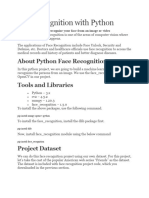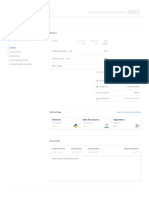0 ratings0% found this document useful (0 votes)
11 viewsPython Libraries
Na
Uploaded by
Phenias ManyashaCopyright
© © All Rights Reserved
We take content rights seriously. If you suspect this is your content, claim it here.
Available Formats
Download as TXT, PDF, TXT or read online on Scribd
0 ratings0% found this document useful (0 votes)
11 viewsPython Libraries
Na
Uploaded by
Phenias ManyashaCopyright
© © All Rights Reserved
We take content rights seriously. If you suspect this is your content, claim it here.
Available Formats
Download as TXT, PDF, TXT or read online on Scribd
You are on page 1/ 3
# import the necessary packages
from tensorflow.keras.applications.xception import preprocess_input
from tensorflow.keras.preprocessing.image import img_to_array
from tensorflow.keras.models import load_model
from imutils.video import VideoStream
from win32com.client import Dispatch
import numpy as np
import imutils
import time
import cv2
import os
import serial
s = serial.Serial('COM1',9600)
def speak(str1):
speak=Dispatch(("SAPI.SpVoice"))
speak.Speak(str1)
def detect_and_predict_mask(frame, faceNet, maskNet):
# grab the dimensions of the frame and then construct a blob
# from it
(h, w) = frame.shape[:2]
blob = cv2.dnn.blobFromImage(frame, 1.0, (224, 224),
(104.0, 177.0, 123.0))
# pass the blob through the network and obtain the face detections
faceNet.setInput(blob)
detections = faceNet.forward()
print(detections.shape)
# initialize our list of faces, their corresponding locations,
# and the list of predictions from our face mask network
faces = []
locs = []
preds = []
# loop over the detections
for i in range(0, detections.shape[2]):
# extract the confidence (i.e., probability) associated with
# the detection
confidence = detections[0, 0, i, 2]
# filter out weak detections by ensuring the confidence is
# greater than the minimum confidence
if confidence > 0.5:
# compute the (x, y)-coordinates of the bounding box for
# the object
box = detections[0, 0, i, 3:7] * np.array([w, h, w, h])
(startX, startY, endX, endY) = box.astype("int")
# ensure the bounding boxes fall within the dimensions of
# the frame
(startX, startY) = (max(0, startX), max(0, startY))
(endX, endY) = (min(w - 1, endX), min(h - 1, endY))
# extract the face ROI, convert it from BGR to RGB channel
# ordering, resize it to 224x224, and preprocess it
face = frame[startY:endY, startX:endX]
face = cv2.cvtColor(face, cv2.COLOR_BGR2RGB)
face = cv2.resize(face, (224, 224))
face = img_to_array(face)
face = preprocess_input(face)
# add the face and bounding boxes to their respective
# lists
faces.append(face)
locs.append((startX, startY, endX, endY))
# only make a predictions if at least one face was detected
if len(faces) > 0:
# for faster inference we'll make batch predictions on *all*
# faces at the same time rather than one-by-one predictions
# in the above `for` loop
faces = np.array(faces, dtype="float32")
preds = maskNet.predict(faces, batch_size=32)
# return a 2-tuple of the face locations and their corresponding
# locations
return (locs, preds)
# load our serialized face detector model from disk
prototxtPath = r"face_detector\deploy.prototxt"
weightsPath = r"face_detector\res10_300x300_ssd_iter_140000.caffemodel"
faceNet = cv2.dnn.readNet(prototxtPath, weightsPath)
# load the face mask detector model from disk
maskNet = load_model("mask_detector.model")
# initialize the video stream
print("[INFO] starting video stream...")
vs = VideoStream(src=0).start()
# loop over the frames from the video stream
while True:
# grab the frame from the threaded video stream and resize it
# to have a maximum width of 400 pixels
frame = vs.read()
frame = imutils.resize(frame, width=400)
# detect faces in the frame and determine if they are wearing a
# face mask or not
(locs, preds) = detect_and_predict_mask(frame, faceNet, maskNet)
# loop over the detected face locations and their corresponding
# locations
for (box, pred) in zip(locs, preds):
# unpack the bounding box and predictions
(startX, startY, endX, endY) = box
(mask, withoutMask) = pred
# determine the class label and color we'll use to draw
# the bounding box and text
label = "Mask" if mask > withoutMask else "No Mask"
if(label == "Mask"):
s.write(b'1')
else:
s.write(b'0') ,speak("put on facemask or wear properly and focus
on camera")
color = (0, 255, 0) if label == "Mask" else (0, 0, 255)
# include the probability in the label
label = "{}: {:.2f}%".format(label, max(mask, withoutMask) * 100)
# display the label and bounding box rectangle on the output
# frame
cv2.putText(frame, label, (startX, startY - 10),
cv2.FONT_HERSHEY_SIMPLEX, 0.45, color, 2)
cv2.rectangle(frame, (startX, startY), (endX, endY), color, 2)
# show the output frame
cv2.imshow("Frame", frame)
key = cv2.waitKey(1) & 0xFF
# if the `q` key was pressed, break from the loop
if key == ord("q"):
break
# do a bit of cleanup
cv2.destroyAllWindows()
vs.stop()
You might also like
- Selected Generalize Function For Face Detection MTCNNNo ratings yetSelected Generalize Function For Face Detection MTCNN4 pages
- Import Face - Recognition Import Import AsNo ratings yetImport Face - Recognition Import Import As2 pages
- Build Face Recognition Attendance System Using PythonNo ratings yetBuild Face Recognition Attendance System Using Python8 pages
- Face Recognition Attendance System Using Python (With Code)No ratings yetFace Recognition Attendance System Using Python (With Code)9 pages
- Count Number of Faces Using Python - OpenCVNo ratings yetCount Number of Faces Using Python - OpenCV13 pages
- Real-Time Face Mask Detection in Video Data: Yuchen Ding, Zichen Li, David Yastremsky University of PennsylvaniaNo ratings yetReal-Time Face Mask Detection in Video Data: Yuchen Ding, Zichen Li, David Yastremsky University of Pennsylvania8 pages
- Detecting and Recognizing: By: Mary Jane Pagay CiervaNo ratings yetDetecting and Recognizing: By: Mary Jane Pagay Cierva34 pages
- Human Face Detection Using CNN 1682855909No ratings yetHuman Face Detection Using CNN 1682855909131 pages
- Face - Recognition - Face - Recognition - Cli - Py at Master Ageitgey - Face - Recognition GitHub PDFNo ratings yetFace - Recognition - Face - Recognition - Cli - Py at Master Ageitgey - Face - Recognition GitHub PDF1 page
- Task 9 Implementation of Object Detection and LocalizationNo ratings yetTask 9 Implementation of Object Detection and Localization7 pages
- Covid-19 Face Mask Detection Using Tensorflow, Keras and OpencvNo ratings yetCovid-19 Face Mask Detection Using Tensorflow, Keras and Opencv5 pages
- Design and Make of A Cost Effective Automated Portable Peritoneal Dialysis MachineNo ratings yetDesign and Make of A Cost Effective Automated Portable Peritoneal Dialysis Machine13 pages
- Introduction To Switched Mode Power Supplies.: Fig.3.0.1 Typical SMPS Block DiagramNo ratings yetIntroduction To Switched Mode Power Supplies.: Fig.3.0.1 Typical SMPS Block Diagram17 pages
- F - Cpu: #Define #Include #Include #IncludeNo ratings yetF - Cpu: #Define #Include #Include #Include8 pages
- Bsee2 LEVEL 3:2 Hydraulic Structures: Assignment 3: Job VagereNo ratings yetBsee2 LEVEL 3:2 Hydraulic Structures: Assignment 3: Job Vagere2 pages
- Major Project Report Formatc - 2023-24 - BCA 30032024No ratings yetMajor Project Report Formatc - 2023-24 - BCA 3003202456 pages
- Python for scientists 1st Edition John M. Stewart - The full ebook set is available with all chapters for download100% (1)Python for scientists 1st Edition John M. Stewart - The full ebook set is available with all chapters for download51 pages
- [Ebooks PDF] download Statistics and Data Visualisation with Python Jesús Rogel-Salazar full chapters100% (6)[Ebooks PDF] download Statistics and Data Visualisation with Python Jesús Rogel-Salazar full chapters50 pages
- Sandeep Nagar Introduction To Python - For Scientists and Engineers PDFNo ratings yetSandeep Nagar Introduction To Python - For Scientists and Engineers PDF141 pages
- Fake Account Detection Using Machine Learning and Data ScienceNo ratings yetFake Account Detection Using Machine Learning and Data Science58 pages
- Python Data Science Handbook Essential Tools for Working with Data 1st Edition Jake Vanderplas download pdf100% (3)Python Data Science Handbook Essential Tools for Working with Data 1st Edition Jake Vanderplas download pdf55 pages






































































































